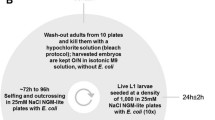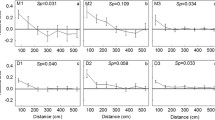Abstract
Several components of fitness were analysed in relation to the presence of a supernumerary chromosome segment (SCS) in two natural populations of the grasshopper Eyprepocnemis plorans, including clutch size, egg fertility, egg and embryo productivity and survivability from embryo to adult, and SCS transmission through males. The results have shown the absence of a significant relationship between SCS presence and these fitness components, with the single exception of egg fertility which decreases significantly in SCS females with mating shortage. This fertility decrease is thus expected to be relevant for the population dynamics of the SCS only in low-density populations, those in which it is difficult for females to find a male to copulate with before each egg-batch is ready to be laid. The analysis of the SCS transmission through males showed no significant differences between expected and observed SCS frequencies. The SCS polymorphism seems to be at a status close to neutrality in respect to fitness, but its slight disadvantage in transmission through females carrying B chromosomes predicts that the polymorphism should tend to disappear, unless SCS recurrent amplification, or another undiscovered force, counteracts this tendency.
Similar content being viewed by others
References
Ainsworth CC, Parker JS, Horton DM (1983) Chromosome variation and evolution in Scilla autumnalis. Kew Chrom Conf 2: 261–268.
Cabrero J (1985) Estudios citogenéticos en saltamontes de la subfamilia gomphocerinae: heterocromatina, reordenaciones cromosómicas y actividad nucleolar. PhD Thesis, Universidad de Granada, Spain.
Cabrero J, Navas-Castillo J, Camacho JPM (1986) Effects of supernumerary chromosome segments on the activity of nucleolar organiser regions in the grasshopper Chorthippus binotatus. Chromosoma 93: 375–380.
Cabrero J, López-León MD, Camacho JPM (1998) Ribosomal DNA in a supernumerary chromosome segment of the grass-hopper Oedipoda fuscocincta confirms its origin by translocation. Hereditas 129: 15–18.
Cabrero J, López-León MD, Bakkali M, Camacho JPM(1999) Common origin of B chromosome variants in the grass-hopper Eyprepocnemis plorans. Heredity 83: 435–439.
Camacho JPM (1980) Variabilidad cromosómica en poblaciones naturales de Tettigonioidea, Pamphagoidea y Acridoidea. PhD. Thesis, Universidad de Granada, Spain.
Camacho JPM, Cabrero J (1987) New hypotheses about the origin of supernumerary chromosome segments in grasshoppers. Heredity 58: 341–343.
Camacho JPM, Viseras E, Navas J, Cabrero J (1984) C-heterochromatin content of supernumerary chromosome segments of grasshoppers: detection of an euchromatic extra segment. Heredity 53: 167–175.
Donaldson KM, Karpen GH (1997) Trans-suppression of terminal deficiency-associated position effect variegation in a Drosophila minichromosome. Genetics 145: 325–337.
Dorer DR, Henikoff S (1997) Transgene repeat arrays interact with distant heterochromatin and cause silencing in cis and trans. Genetics 147: 1181–1190.
Flavell RB (1994) Inactivation of gene-expression in plants as a consequence of specific sequence duplication. Proc Nat Acad Sci USA 91: 3490–3496.
Garrido-Ramos MA, Jamilena M, de la Herrán R, Ruiz-Rejón C, Camacho JPM, Ruiz-Rejón M (1998) Inheritance and fitness effects of a pericentric inversion and a supernumerary chromosome segment in Muscari comosum (Liliaceae). Heredity 80: 724–731.
Henriques-Gil N, Arana P (1990) Origin and substitution of B chromosomes in the grasshopper Eyprepocnemis plorans. Evolution 44: 747–753.
Jamilena M, Martínez F, Garrido-Ramos MA et al. (1995) Inheritance and fitness effects analysis for a euchromatic supernumerary chromosome segment in Scilla autumnalis (Liliaceae). Biol J Linn Soc 118: 249–259.
John B (1981) Heterochromatin variation in natural populations. Chromosomes Today 7: 128–137.
John B, Appels R, Contreras N (1986) Population cytogenetics of Atractomorpha similis. II. Molecular characterisation of the distal C-band polymorphisms. Chromosoma 94: 45–58.
López-León MD, Cabrero J, Camacho JPM (1991) Meiotic drive against an autosomal supernumerary segment pro-moted by the presence of a B chromosome in females of the grasshopper Eyprepocnemis plorans. Chromosoma 100: 282–287.
López-León MD, Cabrero J, Camacho JPM (1992a) Male and female segregation distortion for heterochromatic supernumerary segments on the S8 chromosome of the grasshopper Chorthippus jacobsi. Chromosoma 101: 511–516.
López-León MD, Cabrero J, Camacho JPM, Cano MI, Santos JL (1992b) A widespread B chromosome polymorphism maintained without apparent drive. Evolution 46: 529–539.
López-León MD, Cabrero J, Pardo MC, Viseras E, Camacho JPM (1993) Paternity displacement in the grasshopper Eyprepocnemis plorans. Heredity 71: 539–545.
López-León MD, Neves N, Schwarzacher T, Heslop-Harrison JS, Hewitt GM, Camacho JPM (1994a) Possible origin of a B chromosome deduced from its DNA composition using double FISH technique. Chromosome Res 2: 87–92.
López-León MD, Pardo MC, Cabrero J, Camacho JPM (1994b) Undertransmission of a supernumerary chromosome segment through heterozygous females possessing B chromosomes in the grasshopper Eyprepocnemis plorans. Genome 37: 705–709.
López-León MD, Martín-Alganza A, Pardo MC, Cabrero J, Camacho JPM (1995) Temporal frequency stability and absence of effects on mating behaviour for an autosomal supernumerary segment in two natural populations of the grasshopper Eyprepocnemis plorans. Genome 38: 320–324.
Muñoz E, Perfectti F, Martín-Alganza A, Camacho JPM (1998) Parallel effects of a B chromosome and a mite that decrease female fitness in the grasshopper Eyprepocnemis plorans. Proc R Soc Lond B 265: 1903–1909.
Navas-Castillo J, Cabrero J, Camacho JPM (1985) Chiasma redistribution in bivalents carrying supernumerary chromosome segments in grasshoppers. Heredity 55: 245–248.
Navas-Castillo J, Cabrero J, Camacho JPM (1987) Chiasma redistribution in presence of supernumerary chromosome segments in grashopper: dependence of the size of the extra segment. Heredity 58: 409–412.
Pardo MC, López-León MD, Hewitt GM, Camacho JPM (1995) Female fitness is increased by frequent mating in grasshoppers. Heredity 74: 654–660.
Rhoades MM (1978) Genetic effects of heterochromatin in maize. In: Walker DB, ed. Maize Breeding and Genetics. New York: Wiley Interscience, pp 641–671.
Rossignol JL, Faugeron G (1995) MIP-An epigenetic gene silencing process in Ascobolus immersus. Curr Topics Microbiol Inmunol 197: 179–191.
Ruiz-Rejón C, Lozano R, Ortega-Nieto FJ, Ruiz-Rejón M (1988) B chromosomes and supernumerary chromosome segments in Liliaceae: selfish or heterotic DNA? Kew Chrom Conf 3: 141–149.
Schroeter G, Hewitt GM (1974) The effects of supernumerary chromatin in three species of grasshopper. Can J Genet Cytol 16: 285–296.
de la Torre J, López-Fernández C, Nichols R, Gosálvez J (1986) Heterochromatin readjusting chiasma distribution in two species of the genus Arcyptera: The effects amomg individuals and populations. Heredity 56: 177–184.
Weiler KS, Wakimoto BT (1995) Heterochromatin and gene-expression in Drosophila. Ann Rev Genet 29: 577–605.
Westerman M (1975) Population cytology of the genus Phaulacridium III. P. marginale (Walker); polymorphisms for extra heterochromatin. Heredity 34: 11–27.
Wilby AS, Parker JS (1988) The supernumerary segment system of Rumex acetosa. Heredity 60: 109–117.
Wu CI, True JR, Johnson N(1989) Fitness reduction associated with the deletion of a satellite DNA array. Nature 341: 248–251.
Zurita S, Cabrero J, López-León MD, Camacho JPM (1998) Polymorphism regeneration for a neutralized selfish B chromosome. Evolution 52: 274–277.
Author information
Authors and Affiliations
Rights and permissions
About this article
Cite this article
Perfectti, F., Cabrero, J., López-León, M.D. et al. Fitness effect analysis of a heterochromatic supernumerary segment in the grasshopper Eyprepocnemis plorans . Chromosome Res 8, 425–433 (2000). https://doi.org/10.1023/A:1009214904031
Issue Date:
DOI: https://doi.org/10.1023/A:1009214904031




